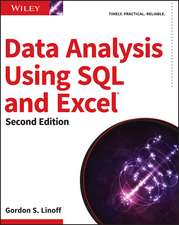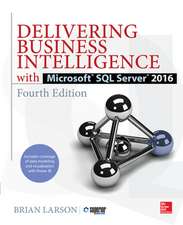The Definitive Guide to DAX: Business Skills
Autor Alberto Ferrari, Marco Russoen Limba Engleză Paperback – 7 dec 2025
- Master core DAX concepts, including calculated columns, measures, and error handling
- Understand evaluation contexts and the CALCULATE and CALCULATETABLE functions
- Perform time-based calculations: YTD, MTD, previous year, working days, and more
- Work with expanded tables, complex functions, and elaborate DAX expressions
- Perform calculations over hierarchies, including parent/child hierarchies
- Use DAX to express diverse and unusual relationships
- Measure DAX query performance with SQL Server Profiler and DAX Studio
| Toate formatele și edițiile | Preț | Express |
|---|---|---|
| Paperback (2) | 274.66 lei 3-5 săpt. | +57.79 lei 4-10 zile |
| Microsoft Press – 28 sep 2019 | 274.66 lei 3-5 săpt. | +57.79 lei 4-10 zile |
| Microsoft Press – 4 oct 2015 | 283.20 lei 17-23 zile | +25.53 lei 4-10 zile |
Din seria Business Skills
- 20%
 Preț: 166.56 lei
Preț: 166.56 lei - 20%
 Preț: 171.64 lei
Preț: 171.64 lei - 20%
 Preț: 186.94 lei
Preț: 186.94 lei - 20%
 Preț: 278.09 lei
Preț: 278.09 lei - 20%
 Preț: 188.88 lei
Preț: 188.88 lei - 20%
 Preț: 186.90 lei
Preț: 186.90 lei - 20%
 Preț: 199.68 lei
Preț: 199.68 lei - 20%
 Preț: 200.13 lei
Preț: 200.13 lei - 20%
 Preț: 254.06 lei
Preț: 254.06 lei - 20%
 Preț: 274.66 lei
Preț: 274.66 lei - 20%
 Preț: 199.75 lei
Preț: 199.75 lei - 20%
 Preț: 232.58 lei
Preț: 232.58 lei - 20%
 Preț: 201.86 lei
Preț: 201.86 lei - 20%
 Preț: 184.23 lei
Preț: 184.23 lei - 20%
 Preț: 195.57 lei
Preț: 195.57 lei - 20%
 Preț: 245.14 lei
Preț: 245.14 lei
Preț: 292.74 lei
Preț vechi: 365.93 lei
-20% Nou
Puncte Express: 439
Preț estimativ în valută:
56.02€ • 58.27$ • 46.25£
56.02€ • 58.27$ • 46.25£
Carte nepublicată încă
Doresc să fiu notificat când acest titlu va fi disponibil:
Se trimite...
Preluare comenzi: 021 569.72.76
Specificații
ISBN-13: 9780138244729
ISBN-10: 0138244723
Ediția:3. Auflage
Editura: Pearson Education (US)
Seria Business Skills
ISBN-10: 0138244723
Ediția:3. Auflage
Editura: Pearson Education (US)
Seria Business Skills
Descriere
Descriere de la o altă ediție sau format:
This comprehensive and authoritative guide will teach you the DAX language for business intelligence, data modeling, and analytics. Leading Microsoft BI consultants Marco Russo and Alberto Ferrari help you master everything from table functions through advanced code and model optimization. You'll learn exactly what happens under the hood when you run a DAX expression, how DAX behaves differently from other languages, and how to use this knowledge to write fast, robust code. If you want to leverage all of DAX's remarkable power and flexibility, this no-compromise "deep dive" is exactly what you need.
Perform powerful data analysis with DAX for Microsoft SQL Server Analysis Services, Excel, and Power BI
- Master core DAX concepts, including calculated columns, measures, and error handling
- Understand evaluation contexts and the CALCULATE and CALCULATETABLE functions
- Perform time-based calculations: YTD, MTD, previous year, working days, and more
- Work with expanded tables, complex functions, and elaborate DAX expressions
- Perform calculations over hierarchies, including parent/child hierarchies
- Use DAX to express diverse and unusual relationships
- Measure DAX query performance with SQL Server Profiler and DAX Studio
Notă biografică
Cuprins
Foreword xvii
Introduction xix
Chapter 1: What is DAX? 1
Understanding the data model 1
Understanding the direction of a relationship 3
DAX for Excel users 5
Cells versus tables 5
Excel and DAX: Two functional languages 8
Using iterators 8
DAX requires some theory 8
DAX for SQL developers 9
Understanding relationship handling 9
DAX is a functional language 10
DAX as a programming and querying language 11
Subqueries and conditions in DAX and SQL 12
DAX for MDX developers 13
Multidimensional vs. Tabular 13
DAX as a programming and querying language 13
Hierarchies 14
Leaf-level calculations 15
Chapter 2: Introducing DAX 17
Understanding DAX calculations 17
DAX data types 18
DAX operators 21
Understanding calculated columns and measures 22
Calculated columns 22
Measures 23
Variables 26
Handling errors in DAX expressions 26
Conversion errors 26
Arithmetical operations errors 27
Intercepting errors 30
Formatting DAX code 32
Common DAX functions 35
Aggregate functions 35
Logical functions 37
Information functions 39
Mathematical functions 39
Trigonometric functions 40
Text functions 40
Conversion functions 41
Date and time functions 42
Relational functions 42
Chapter 3: Using basic table functions 45
Introducing table functions 45
EVALUATE syntax 47
Using table expressions 50
Understanding FILTER 51
Understanding ALL, ALLEXCEPT, and ALLNOBLANKROW 54
Understanding VALUES and DISTINCT 58
Using VALUES as a scalar value 59
Chapter 4: Understanding evaluation contexts 61
Introduction to evaluation contexts 62
Understanding the row context 66
Testing your evaluation context understanding 67
Using SUM in a calculated column 67
Using columns in a measure 68
Creating a row context with iterators 69
Using the EARLIER function 70
Understanding FILTER, ALL, and context interactions 74
Working with many tables 77
Row contexts and relationships 78
Filter context and relationships 80
Introducing VALUES 84
Introducing ISFILTERED, ISCROSSFILTERED 85
Evaluation contexts recap 88
Creating a parameter table 89
Chapter 5: Understanding CALCULATE and CALCULATETABLE 93
Understanding CALCULATE 93
Understanding the filter context 95
Introducing CALCULATE 98
CALCULATE examples 101
Filtering a single column 101
Filtering with complex conditions 106
Using CALCULATETABLE 109
Understanding context transition 111
Understanding context transition with measures 114
How many rows are visible after context transition? 116
Understanding evaluation order of context transition 117
Variables and evaluation contexts 118
Understanding circular dependencies 119
CALCULATE rules 122
Introducing ALLSELECTED 123
Understanding USERELATIONSHIP 125
Chapter 6: DAX examples 129
Computing ratios and percentages 129
Computing cumulative totals 132
Using ABC (Pareto) classification 136
Computing sales per day and working day 143
Computing differences in working days 150
Computing static moving averages 151
Chapter 7: Time intelligence calculations 155
Introduction to time intelligence 155
Building a Date table 156
Using CALENDAR and CALENDARAUTO 157
Working with multiple dates 160
Handling multiple relationships to the Date table 161
Handling multiple Date tables 162
Introduction to time intelligence 164
Using Mark as Date Table 166
Aggregating and comparing over time 168
Year-to-date, quarter-to-date, month-to-date 168
Computing periods from prior periods 171
Computing difference over previous periods 174
Computing the moving annual total 175
Closing balance over time 178
Semi-additive measures 178
OPENINGBALANCE and CLOSINGBALANCE functions 184
Advanced time intelligence 188
Understanding periods to date 189
Understanding DATEADD 191
Understanding FIRSTDATE and LASTDATE 196
Understanding FIRSTNONBLANK and LASTNONBLANK 199
Using drillthrough with time intelligence 200
Custom calendars 200
Working with weeks 201
Custom year-to-date, quarter-to-date, month-to-date 204
Computing over noncontiguous periods 206
Custom comparison between periods 210
Chapter 8: Statistical functions 213
Using RANKX 213
Common pitfalls using RANKX 216
Using RANK.EQ 219
Computing average and moving average 220
Computing variance and standard deviation 222
Computing median and percentiles 223
Computing interests 225
Alternative implementation of PRODUCT and GEOMEAN 226
Using internal rate of return (XIRR) 227
Using net present value (XNPV) 228
Using Excel statistical functions 229
Sampling by using the SAMPLE function 230
Chapter 9: Advanced table functions 233
Understanding EVALUATE 233
Using VAR in EVALUATE 235
Understanding filter functions 236
Using CALCULATETABLE 236
Using TOPN 239
Understanding projection functions 241
Using ADDCOLUMNS 241
Using SELECTCOLUMNS 244
Using ROW 247
Understanding lineage and relationships 248
Understanding grouping/joining functions 250
Using SUMMARIZE 250
Using SUMMARIZECOLUMNS 255
Using GROUPBY 261
Using ADDMISSINGITEMS 262
Using NATURALINNERJOIN 265
Using NATURALLEFTOUTERJOIN 266
Understanding set functions 267
Using CROSSJOIN 267
Using UNION 269
Using INTERSECT 272
Using EXCEPT 274
Using GENERATE, GENERATEALL 275
Understanding utility functions 278
Using CONTAINS 278
Using LOOKUPVALUE 280
Using SUBSTITUTEWITHINDEX 283
Using ISONORAFTER 284
Chapter 10: Advanced evaluation context 285
Understanding ALLSELECTED 285
Understanding KEEPFILTERS 294
Understanding AutoExists 304
Understanding expanded tables 307
Difference between table expansion and filtering 315
Redefining the filter context 316
Understanding filter context intersection 318
Understanding filter context overwrite 320
Understanding arbitrarily shaped filters 321
Understanding the ALL function 326
Understanding lineage 329
Using advanced SetFilter 331
Learning and mastering evaluation contexts 338
Chapter 11: Handling hierarchies 339
Computing percentages over hierarchies 339
Handling parent-child hierarchies 346
Handling unary operators 358
Implementing unary operators by using DAX 359
Chapter 12: Advanced relationships 367
Using calculated physical relationships 367
Computing multiple-column relationships 367
Computing static segmentation 369
Using virtual relationships 371
Using dynamic segmentation 371
Many-to-many relationships 373
Using relationships with different granularities 378
Differences between physical and virtual relationships 381
Finding missing relationships 382
Computing number of products not sold 383
Computing new and returning customers 384
Examples of complex relationships 386
Performing currency conversion 386
Frequent itemset search 392
Chapter 13: The VertiPaq engine 399
Understanding database processing 400
Introduction to columnar databases 400
Understanding VertiPaq compression 403
Understanding value encoding 404
Understanding dictionary encoding 405
Understanding Run Length Encoding (RLE) 406
Understanding re-encoding 409
Finding the best sort order 409
Understanding hierarchies and relationships 410
Understanding segmentation and partitioning 412
Using Dynamic Management Views 413
Using DISCOVER_OBJECT_MEMORY_USAGE 414
Using DISCOVER_STORAGE_TABLES 414
Using DISCOVER_STORAGE_TABLE_COLUMNS 415
Using DISCOVER_STORAGE_TABLE_COLUMN_SEGMENTS 416
Understanding materialization 417
Choosing hardware for VertiPaq 421
Can you choose hardware? 421
Set hardware priorities 421
CPU model 422
Memory speed 423
Number of cores 423
Memory size 424
Disk I/O and paging 424
Conclusions 424
Chapter 14: Optimizing data models 425
Gathering information about the data model 425
Denormalization 434
Columns cardinality 442
Handling date and time 443
Calculated columns 447
Optimizing complex filters with Boolean calculated columns 450
Choosing the right columns to store 451
Optimizing column storage 453
Column split optimization 453
Optimizing high cardinality columns 454
Optimizing drill-through attributes 455
Chapter 15: Analyzing DAX query plans 457
Introducing the DAX query engine 457
Understanding the formula engine 458
Understanding the storage engine (VertiPaq) 459
Introducing DAX query plans 459
Logical query plan 460
Physical query plan 461
Storage engine query 462
Capturing profiling information 463
Using the SQL Server Profiler 463
Using DAX Studio 467
Reading storage engine queries 470
Introducing xmSQL syntax 470
Understanding scan time 477
Understanding DISTINCTCOUNT internals 479
Understanding parallelism and datacache 480
Understanding the VertiPaq cache 481
Understanding CallbackDataID 483
Reading query plans 488
Chapter 16: Optimizing DAX 495
Defining optimization strategy 496
Identifying a single DAX expression to optimize 496
Creating a reproduction query 499
Analyzing server timings and query plan information 500
Identifying bottlenecks in the storage engine or formula engine 503
Optimizing bottlenecks in the storage engine 504
Choosing ADDCOLUMNS vs. SUMMARIZE 505
Reducing CallbackDataID impact 509
Optimizing filter conditions 512
Optimizing IF conditions 513
Optimizing cardinality 515
Optimizing nested iterators 517
Optimizing bottlenecks in the formula engine 522
Creating repro in MDX 527
Reducing materialization 528
Optimizing complex bottlenecks 532
Index 537
Introduction xix
Chapter 1: What is DAX? 1
Understanding the data model 1
Understanding the direction of a relationship 3
DAX for Excel users 5
Cells versus tables 5
Excel and DAX: Two functional languages 8
Using iterators 8
DAX requires some theory 8
DAX for SQL developers 9
Understanding relationship handling 9
DAX is a functional language 10
DAX as a programming and querying language 11
Subqueries and conditions in DAX and SQL 12
DAX for MDX developers 13
Multidimensional vs. Tabular 13
DAX as a programming and querying language 13
Hierarchies 14
Leaf-level calculations 15
Chapter 2: Introducing DAX 17
Understanding DAX calculations 17
DAX data types 18
DAX operators 21
Understanding calculated columns and measures 22
Calculated columns 22
Measures 23
Variables 26
Handling errors in DAX expressions 26
Conversion errors 26
Arithmetical operations errors 27
Intercepting errors 30
Formatting DAX code 32
Common DAX functions 35
Aggregate functions 35
Logical functions 37
Information functions 39
Mathematical functions 39
Trigonometric functions 40
Text functions 40
Conversion functions 41
Date and time functions 42
Relational functions 42
Chapter 3: Using basic table functions 45
Introducing table functions 45
EVALUATE syntax 47
Using table expressions 50
Understanding FILTER 51
Understanding ALL, ALLEXCEPT, and ALLNOBLANKROW 54
Understanding VALUES and DISTINCT 58
Using VALUES as a scalar value 59
Chapter 4: Understanding evaluation contexts 61
Introduction to evaluation contexts 62
Understanding the row context 66
Testing your evaluation context understanding 67
Using SUM in a calculated column 67
Using columns in a measure 68
Creating a row context with iterators 69
Using the EARLIER function 70
Understanding FILTER, ALL, and context interactions 74
Working with many tables 77
Row contexts and relationships 78
Filter context and relationships 80
Introducing VALUES 84
Introducing ISFILTERED, ISCROSSFILTERED 85
Evaluation contexts recap 88
Creating a parameter table 89
Chapter 5: Understanding CALCULATE and CALCULATETABLE 93
Understanding CALCULATE 93
Understanding the filter context 95
Introducing CALCULATE 98
CALCULATE examples 101
Filtering a single column 101
Filtering with complex conditions 106
Using CALCULATETABLE 109
Understanding context transition 111
Understanding context transition with measures 114
How many rows are visible after context transition? 116
Understanding evaluation order of context transition 117
Variables and evaluation contexts 118
Understanding circular dependencies 119
CALCULATE rules 122
Introducing ALLSELECTED 123
Understanding USERELATIONSHIP 125
Chapter 6: DAX examples 129
Computing ratios and percentages 129
Computing cumulative totals 132
Using ABC (Pareto) classification 136
Computing sales per day and working day 143
Computing differences in working days 150
Computing static moving averages 151
Chapter 7: Time intelligence calculations 155
Introduction to time intelligence 155
Building a Date table 156
Using CALENDAR and CALENDARAUTO 157
Working with multiple dates 160
Handling multiple relationships to the Date table 161
Handling multiple Date tables 162
Introduction to time intelligence 164
Using Mark as Date Table 166
Aggregating and comparing over time 168
Year-to-date, quarter-to-date, month-to-date 168
Computing periods from prior periods 171
Computing difference over previous periods 174
Computing the moving annual total 175
Closing balance over time 178
Semi-additive measures 178
OPENINGBALANCE and CLOSINGBALANCE functions 184
Advanced time intelligence 188
Understanding periods to date 189
Understanding DATEADD 191
Understanding FIRSTDATE and LASTDATE 196
Understanding FIRSTNONBLANK and LASTNONBLANK 199
Using drillthrough with time intelligence 200
Custom calendars 200
Working with weeks 201
Custom year-to-date, quarter-to-date, month-to-date 204
Computing over noncontiguous periods 206
Custom comparison between periods 210
Chapter 8: Statistical functions 213
Using RANKX 213
Common pitfalls using RANKX 216
Using RANK.EQ 219
Computing average and moving average 220
Computing variance and standard deviation 222
Computing median and percentiles 223
Computing interests 225
Alternative implementation of PRODUCT and GEOMEAN 226
Using internal rate of return (XIRR) 227
Using net present value (XNPV) 228
Using Excel statistical functions 229
Sampling by using the SAMPLE function 230
Chapter 9: Advanced table functions 233
Understanding EVALUATE 233
Using VAR in EVALUATE 235
Understanding filter functions 236
Using CALCULATETABLE 236
Using TOPN 239
Understanding projection functions 241
Using ADDCOLUMNS 241
Using SELECTCOLUMNS 244
Using ROW 247
Understanding lineage and relationships 248
Understanding grouping/joining functions 250
Using SUMMARIZE 250
Using SUMMARIZECOLUMNS 255
Using GROUPBY 261
Using ADDMISSINGITEMS 262
Using NATURALINNERJOIN 265
Using NATURALLEFTOUTERJOIN 266
Understanding set functions 267
Using CROSSJOIN 267
Using UNION 269
Using INTERSECT 272
Using EXCEPT 274
Using GENERATE, GENERATEALL 275
Understanding utility functions 278
Using CONTAINS 278
Using LOOKUPVALUE 280
Using SUBSTITUTEWITHINDEX 283
Using ISONORAFTER 284
Chapter 10: Advanced evaluation context 285
Understanding ALLSELECTED 285
Understanding KEEPFILTERS 294
Understanding AutoExists 304
Understanding expanded tables 307
Difference between table expansion and filtering 315
Redefining the filter context 316
Understanding filter context intersection 318
Understanding filter context overwrite 320
Understanding arbitrarily shaped filters 321
Understanding the ALL function 326
Understanding lineage 329
Using advanced SetFilter 331
Learning and mastering evaluation contexts 338
Chapter 11: Handling hierarchies 339
Computing percentages over hierarchies 339
Handling parent-child hierarchies 346
Handling unary operators 358
Implementing unary operators by using DAX 359
Chapter 12: Advanced relationships 367
Using calculated physical relationships 367
Computing multiple-column relationships 367
Computing static segmentation 369
Using virtual relationships 371
Using dynamic segmentation 371
Many-to-many relationships 373
Using relationships with different granularities 378
Differences between physical and virtual relationships 381
Finding missing relationships 382
Computing number of products not sold 383
Computing new and returning customers 384
Examples of complex relationships 386
Performing currency conversion 386
Frequent itemset search 392
Chapter 13: The VertiPaq engine 399
Understanding database processing 400
Introduction to columnar databases 400
Understanding VertiPaq compression 403
Understanding value encoding 404
Understanding dictionary encoding 405
Understanding Run Length Encoding (RLE) 406
Understanding re-encoding 409
Finding the best sort order 409
Understanding hierarchies and relationships 410
Understanding segmentation and partitioning 412
Using Dynamic Management Views 413
Using DISCOVER_OBJECT_MEMORY_USAGE 414
Using DISCOVER_STORAGE_TABLES 414
Using DISCOVER_STORAGE_TABLE_COLUMNS 415
Using DISCOVER_STORAGE_TABLE_COLUMN_SEGMENTS 416
Understanding materialization 417
Choosing hardware for VertiPaq 421
Can you choose hardware? 421
Set hardware priorities 421
CPU model 422
Memory speed 423
Number of cores 423
Memory size 424
Disk I/O and paging 424
Conclusions 424
Chapter 14: Optimizing data models 425
Gathering information about the data model 425
Denormalization 434
Columns cardinality 442
Handling date and time 443
Calculated columns 447
Optimizing complex filters with Boolean calculated columns 450
Choosing the right columns to store 451
Optimizing column storage 453
Column split optimization 453
Optimizing high cardinality columns 454
Optimizing drill-through attributes 455
Chapter 15: Analyzing DAX query plans 457
Introducing the DAX query engine 457
Understanding the formula engine 458
Understanding the storage engine (VertiPaq) 459
Introducing DAX query plans 459
Logical query plan 460
Physical query plan 461
Storage engine query 462
Capturing profiling information 463
Using the SQL Server Profiler 463
Using DAX Studio 467
Reading storage engine queries 470
Introducing xmSQL syntax 470
Understanding scan time 477
Understanding DISTINCTCOUNT internals 479
Understanding parallelism and datacache 480
Understanding the VertiPaq cache 481
Understanding CallbackDataID 483
Reading query plans 488
Chapter 16: Optimizing DAX 495
Defining optimization strategy 496
Identifying a single DAX expression to optimize 496
Creating a reproduction query 499
Analyzing server timings and query plan information 500
Identifying bottlenecks in the storage engine or formula engine 503
Optimizing bottlenecks in the storage engine 504
Choosing ADDCOLUMNS vs. SUMMARIZE 505
Reducing CallbackDataID impact 509
Optimizing filter conditions 512
Optimizing IF conditions 513
Optimizing cardinality 515
Optimizing nested iterators 517
Optimizing bottlenecks in the formula engine 522
Creating repro in MDX 527
Reducing materialization 528
Optimizing complex bottlenecks 532
Index 537

















